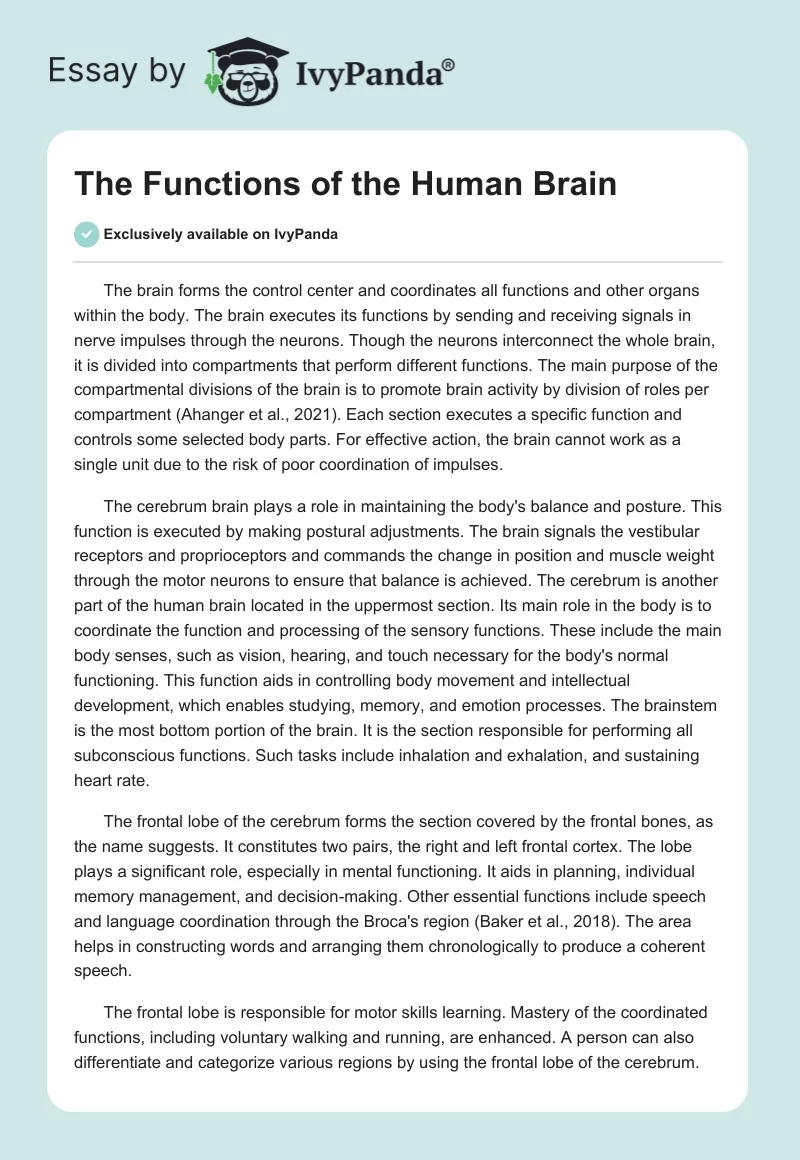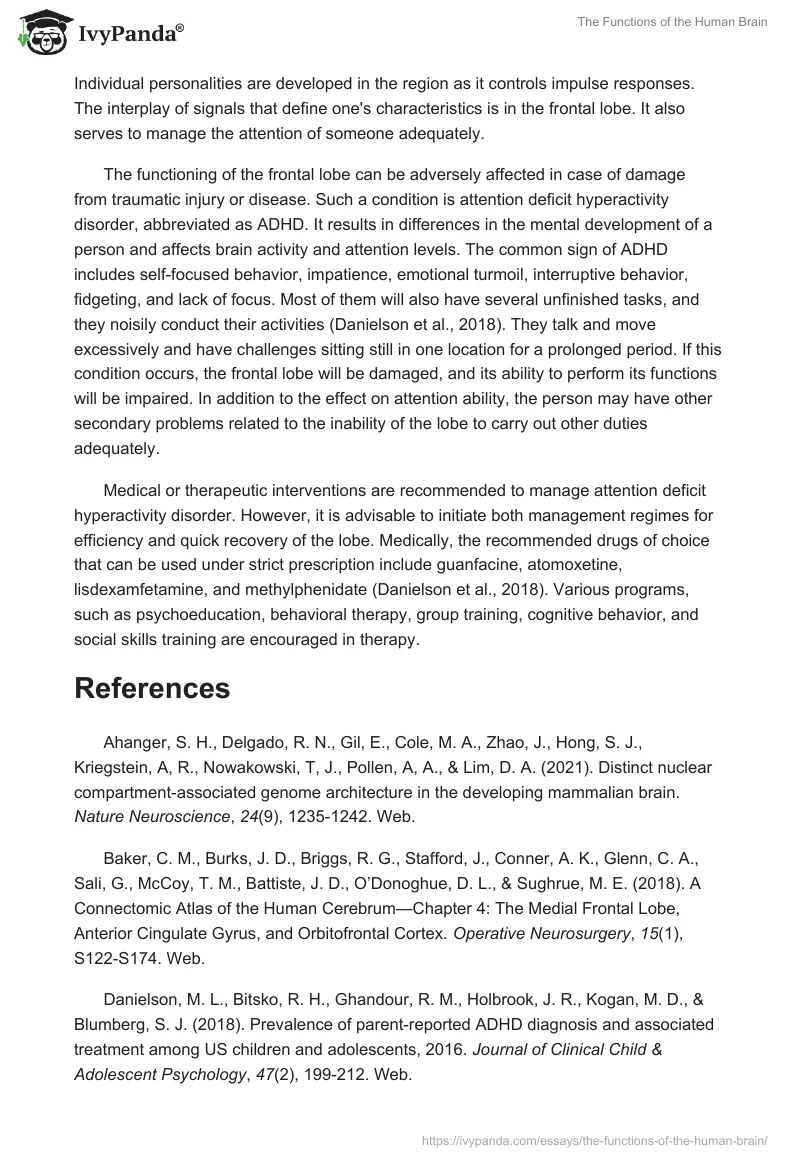The brain forms the control center and coordinates all functions and other organs within the body. The brain executes its functions by sending and receiving signals in nerve impulses through the neurons. Though the neurons interconnect the whole brain, it is divided into compartments that perform different functions. The main purpose of the compartmental divisions of the brain is to promote brain activity by division of roles per compartment (Ahanger et al., 2021). Each section executes a specific function and controls some selected body parts. For effective action, the brain cannot work as a single unit due to the risk of poor coordination of impulses.
The cerebrum brain plays a role in maintaining the body’s balance and posture. This function is executed by making postural adjustments. The brain signals the vestibular receptors and proprioceptors and commands the change in position and muscle weight through the motor neurons to ensure that balance is achieved. The cerebrum is another part of the human brain located in the uppermost section. Its main role in the body is to coordinate the function and processing of the sensory functions. These include the main body senses, such as vision, hearing, and touch necessary for the body’s normal functioning. This function aids in controlling body movement and intellectual development, which enables studying, memory, and emotion processes. The brainstem is the most bottom portion of the brain. It is the section responsible for performing all subconscious functions. Such tasks include inhalation and exhalation, and sustaining heart rate.
The frontal lobe of the cerebrum forms the section covered by the frontal bones, as the name suggests. It constitutes two pairs, the right and left frontal cortex. The lobe plays a significant role, especially in mental functioning. It aids in planning, individual memory management, and decision-making. Other essential functions include speech and language coordination through the Broca’s region (Baker et al., 2018). The area helps in constructing words and arranging them chronologically to produce a coherent speech.
The frontal lobe is responsible for motor skills learning. Mastery of the coordinated functions, including voluntary walking and running, are enhanced. A person can also differentiate and categorize various regions by using the frontal lobe of the cerebrum. Individual personalities are developed in the region as it controls impulse responses. The interplay of signals that define one’s characteristics is in the frontal lobe. It also serves to manage the attention of someone adequately.
The functioning of the frontal lobe can be adversely affected in case of damage from traumatic injury or disease. Such a condition is attention deficit hyperactivity disorder, abbreviated as ADHD. It results in differences in the mental development of a person and affects brain activity and attention levels. The common sign of ADHD includes self-focused behavior, impatience, emotional turmoil, interruptive behavior, fidgeting, and lack of focus. Most of them will also have several unfinished tasks, and they noisily conduct their activities (Danielson et al., 2018). They talk and move excessively and have challenges sitting still in one location for a prolonged period. If this condition occurs, the frontal lobe will be damaged, and its ability to perform its functions will be impaired. In addition to the effect on attention ability, the person may have other secondary problems related to the inability of the lobe to carry out other duties adequately.
Medical or therapeutic interventions are recommended to manage attention deficit hyperactivity disorder. However, it is advisable to initiate both management regimes for efficiency and quick recovery of the lobe. Medically, the recommended drugs of choice that can be used under strict prescription include guanfacine, atomoxetine, lisdexamfetamine, and methylphenidate (Danielson et al., 2018). Various programs, such as psychoeducation, behavioral therapy, group training, cognitive behavior, and social skills training are encouraged in therapy.
References
Ahanger, S. H., Delgado, R. N., Gil, E., Cole, M. A., Zhao, J., Hong, S. J., Kriegstein, A, R., Nowakowski, T, J., Pollen, A, A., & Lim, D. A. (2021). Distinct nuclear compartment-associated genome architecture in the developing mammalian brain. Nature Neuroscience, 24(9), 1235-1242. Web.
Baker, C. M., Burks, J. D., Briggs, R. G., Stafford, J., Conner, A. K., Glenn, C. A., Sali, G., McCoy, T. M., Battiste, J. D., O’Donoghue, D. L., & Sughrue, M. E. (2018). A Connectomic Atlas of the Human Cerebrum—Chapter 4: The Medial Frontal Lobe, Anterior Cingulate Gyrus, and Orbitofrontal Cortex. Operative Neurosurgery, 15(1), S122-S174. Web.
Danielson, M. L., Bitsko, R. H., Ghandour, R. M., Holbrook, J. R., Kogan, M. D., & Blumberg, S. J. (2018). Prevalence of parent-reported ADHD diagnosis and associated treatment among US children and adolescents, 2016. Journal of Clinical Child & Adolescent Psychology, 47(2), 199-212. Web.


